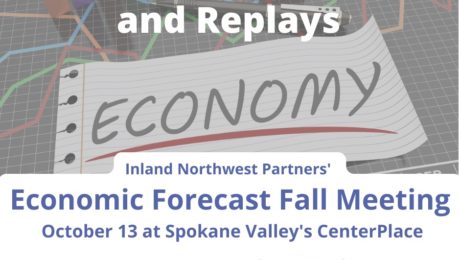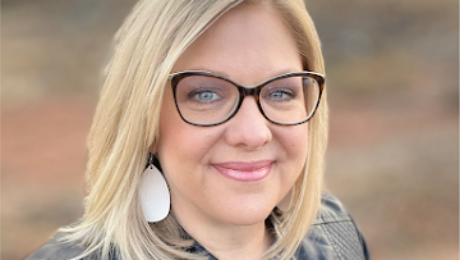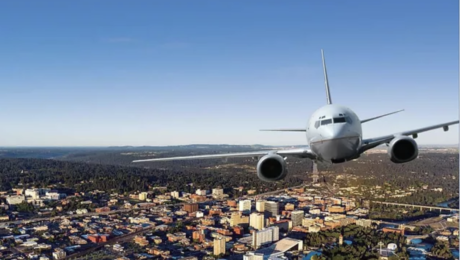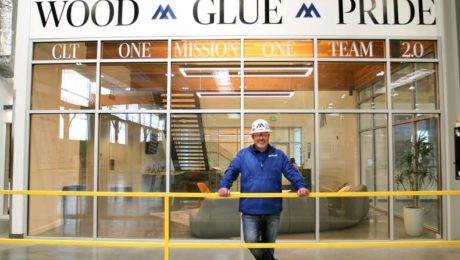Spokane Recognized for Microbusiness Growth
Excerpts from a report based on the Milken Institute’s “Best-Performing Cities Index” and data on microbusinesses from the GoDaddy Venture Forward Initiative. Published October 2022. Authors are Charlotte Kesteven, Abraham Song, PhD, and Caroline Choi.
The Milken Institute’s Best-Performing Cities index compares economic activity across 400 large and small cities in the US annually. It ranks cities on measures including jobs growth, wage growth, high-tech GDP, high-tech industry activity, broadband access, and housing affordability.
The analysis divided the cities in the BPC large cities index into four segments: high rank versus low rank (2022) and high change versus low change (from 2021 to 2022). We selected several cities from each quadrant as case studies for further
examination. Cities were selected from those with the greatest change in each quadrant and to ensure a geographic spread across the country. We then cross-tabulated these cities by category with MAI to identify any key similarities and differences in groups. The top-level results for selected cities are shown below.
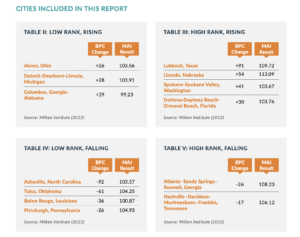
SPOKANE–SPOKANE VALLEY
Spokane scored well in one-year jobs growth, placing seventh among tier two cities in BPC’s annual index, 34th in one-year high-tech GDP growth, 35th in five-year high-tech GDP growth, and 10th in broadband access.
Despite its composite score of 108.9 in the Microbusiness Activity Index, 7.1 points above the national average, Spokane’s subindex engagement and participation scores were particularly low at 100.8 and 102.0, respectively, compared to its fellow quadrant cities. However, the city’s subindex infrastructure score is 11.1 points above the national average, at 114.1. This demonstrates that the city has the physical and intellectual infrastructure needed to access and use the internet, implying that its already diversified economy can grow stronger with a push toward online microbusiness engagement.
Spokane is Washington’s second-largest city and has seen 9.9 percent population growth over the past
decade.2 Between February 1, 2020, and January 7, 2022, Spokane trailed only Boise City, Idaho, for the metro with the fastest growth in job postings. 3 This growth may reflect the fact that Spokane’s major industries in aerospace, health care, food processing, and clean energy production are all rebounding from pandemic–related interruptions.
Job postings may also be growing to meet service- sector demand from remote workers from bigger metros. Attracted by its quality of life, proximity to nature, and small-town environment, remote workers have flocked to Spokane. This movement, however, creates high housing demand, compounded by a lack of affordable housing options in the area: Affordability
is down more than 7 percent year-over-year, 4 and home-value growth has gone up by 12.9 percent year-over-year.5 Spokane has also seen an increase in tech startup activity. Rover, a Seattle-based pet-sitting company, recently set up a 70-person outpost in Spokane, and the University of Washington’s CoMotion Labs launched an innovation hub in the area.6 Tech job
postings almost doubled from 2020 to 2021,7 part of a burgeoning tech industry in Spokane. Despite this, technology only accounts for 1.4 percent of Greater Spokane’s economy, leaving tremendous room for future tech growth and economic diversification.8
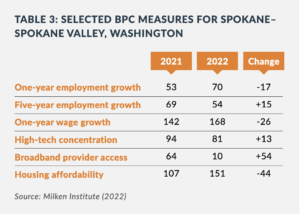
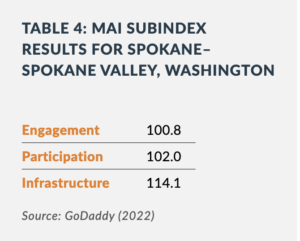
For full report, please click here: Best-Performing-Cities-and-Microbusiness-Activity
- Published in News + Updates
Inland Northwest economic forecast to be presented in Spokane Valley
September 20, 2022 (FAIRFIELD, Wash.)—Inland Northwest Partners (INP) is accepting registrations for the annual regional economic forecast review to be held in Spokane Valley in October. Headlining the event is John W. Mitchell, principal at M&H Economic Consultants, with his keynote presentation titled “Shocks, Mistakes and Replays”. Mitchell shares the stage with economic and community development specialists who will provide timely information on our national and regional economy. The INP Economic Forecast Fall Meeting is Thursday, October 13 from 8:30 a.m.-2:00 p.m. at CenterPlace Event Center, 2426 N. Discovery Place in Spokane Valley. Cost is $40 for INP members and $60 for non-members. Register at www.inwp.org/events.
Spokane International Airport is the headline sponsor for the fall meeting, which also features Sam Wolkenhauer, Labor Economist with the Idaho Department of Labor, to discuss demographic shifts and transitions occurring in our labor markets; and Grant Forsyth, Senior Economist with Avista Corporation, who will provide regional perspectives on inflation and the impacts on both households and businesses.
“The Inland Northwest Partners continues to provide important and relevant community economic development topics to our Inland Northwest business leaders, elected officials, chambers and economic development professionals,” says Paul Kimmell, Chairman of INP Board of Directors.
“Rob Curley, Executive Editor of the Spokesman Review, is a great addition to our meeting lineup,” adds Kimmell. “Rob’s presentation on the Virtuous Circle — why moments of goodness often create more and more goodness — truly demonstrate Rob’s commitment to positive community building. That’s never a message that gets old.”
INP members meet quarterly to share common economic challenges and solutions within the eastern Washington and northern Idaho region. Topics can include technology, financing community initiatives, forging regional partnerships, civic capacity-building, business expansion and retention strategies, and talent attraction. INP often partners with local chambers or state organizations for value-added training.
For more information about INP meetings or becoming a member, visit inwp.org or email [email protected].
************************
Inland Northwest Partners (INP) is a non-profit organization focused on enhancing the long-term vitality of a two-state region through its core offering of educational meetings, programs, and seminars. More than 300 business and community leaders from eastern Washington and northern Idaho are members. INP is also part of a regional collaborative known as the Inland Northwest Economic Alliance (INEA), a consortium of fourteen economic development agencies. To learn more, visit inwp.org.
Story Contact:
KayDee Gilkey, Executive Director, Inland Northwest Partners
P| (509) 990-6105 E| [email protected]
- Published in News + Updates
Jump starting communities for success is topic for upcoming economic development meeting
June 13, 2022 (FAIRFIELD, Wash.)—Inland Northwest Partners (INP) is accepting registrations for a June meeting in Hayden Lake, Idaho. Rural economic development specialist, Jimi Coplen, will share her strategies for creating a spark in small communities. “Jump Starting Your Community for Success”, is Tuesday, June 28 from 8:30 a.m.-2:00 p.m. at Hayden Lake Country Club. Cost is $40 for INP members and $60 for non-members. Seating is limited. Register at www.inwp.org/events.
Jimi Coplen has been an economic and community development practitioner for 20 years, serving in small rural communities in Texas. During the pandemic, she launched an online platform, The Rural Spark, as an educational, and networking platform for other rural economic developers.
“My hope is to empower a new generation to lead their communities and lead strong”, says Coplen. “The pandemic created a shift. People are coming back to rural communities. They are buying homes, starting businesses, retiring, putting kids into our schools. Now more than ever, we need strong economic development professionals and programs.”
INP members meet quarterly to share common economic challenges and solutions within the eastern Washington and northern Idaho region. Topics can include technology, financing community initiatives, forging regional partnerships, civic capacity-building, business expansion and retention strategies, and talent attraction. INP often partners with local chambers or state organizations for value-added training.
For more information about INP meetings or becoming a member, visit inwp.org or email [email protected].
************************
Inland Northwest Partners (INP) is a non-profit organization focused on enhancing the long-term vitality of a two-state region through its core offering of educational meetings, programs, and seminars. More than 300 business and community leaders from eastern Washington and northern Idaho are members. INP is also part of a regional collaborative known as the Inland Northwest Economic Alliance (INEA), a consortium of fourteen economic development agencies. To learn more, visit inwp.org.
Story Contact:
KayDee Gilkey, Executive Director, Inland Northwest Partners
P| (509) 990-6105 E| [email protected]
- Published in News + Updates
I-90 Aerospace Corridor Conference & Expo set for May 31-June 1
After a two year hiatus, the I-90 Aerospace Corridor Conference & Expo is returning to the Coeur d’Alene Resort in Coeur d’Alene, Idaho on May 31-June 1. This event, the premier aerospace-focused conference in the Inland Northwest, will feature a full line up of great industry speakers, a trade show featuring a wide cross-section of suppliers and service providers, B2B meetings with OEMs and Tier 1 and 2 suppliers, and ample networking opportunities.
To see all the participation options visit the event website.
- Published in News + Updates
Spokane cross-laminated timber maker plans $50M in upgrades
Less than a year after buying shuttered Katerra plant, manufacturer looks to increase production
Less than a year after buying the shuttered Katerra plant in Spokane Valley, Mercer Mass Timber LLC plans to invest $50 million in capital projects at the cross-laminated timber factory over the next two years.
The timber-products company has hired 80% of previous Katerra employees at the site since opening last fall. Starting in July, the plant, which currently has 50 employees, will hire roughly 30 additional people to run a second shift, says Jason Herman, plant manager for Mercer Mass Timber.
Envisioned capital projects include expanding the facility, adding new equipment lines, and the addition of a new product line, including glue-laminated structural components, or “glulam.”
Mercer’s main product, cross-laminated timber, or CLT, consists of several layers of kiln-dried lumber boards that are stacked in alternating directions, bonded with structural adhesives, and pressed to form a solid, straight, rectangular panel. Those wood panels are then cut to size and include door and window openings.
Glulam is constructed with all wood layers oriented in the same direction and is ideally used as structural support such as columns and beams.
About two-thirds of a mass timber building is made up of CLT and one-third is glulam, explains Herman. The facility is currently under the process of being qualified for glulam, with production most likely starting sometime in the summer.
“We’re ramping up right now,” says Herman. “With Mercer, we want to add glulam because it’s what mass timber needs.”
Mercer Mass Timber LLC is a subsidiary of the Vancouver, British Columbia-based Mercer International Inc., a global producer of market pulp and solid wood products with mills in Canada, Germany, and Australia.
Established in 1968, Mercer has over 50 years of experience operating in wood manufacturing.
The Spokane Valley CLT plant, located at 19202 E. Garland, is the company’s first factory in the U.S. and its first foray into the mass timber industry.
Mercer acquired the 253,000-square-foot facility—one of the largest CLT production facilities in North America—last summer for $50 million from Katerra Inc., which filed for bankruptcy in June and laid off 63 employees in Spokane Valley.
“We’re really excited that this landed in the right place,” says Todd Beyreuther, director of product for Mercer Mass Timber. “It would have been sad to see it go down.”
Beyreuther and Herman both were involved in the original planning and launch of the facility under Katerra, which began production in 2018. In total, the facility cost $180 million to build, says Herman.
The CLT manufacturing facility is on 37 acres of land at 19202 E. Garland, in northeast Spokane Valley.
When Mercer acquired the plant last August, the company stated in a press release that the plant represents 30% of the current North American mass timber manufacturing capacity and has a capacity to supply about 13 million square feet of five-ply panels, or about 140,000 cubic meters of yearly production.
Herman says that the plant is focused on getting into full production, and a second shift is necessary to do so.
While Katerra sought to be a one-stop-shop CLT company that included building design, manufacturing, and on-site construction, Herman says that Mercer is just focused on manufacturing.
“It’s not fully integrated from design to manufacturing to construction,” says Herman. “What’s different is we are a standalone manufacturing plant.”
The plant receives daily requests for product information and sends out 20 to 30 quotes a week, he says. It’s currently working on five projects from across the country.
Projects are made to customer specifications, says Beyreuther. Mercer works with architects, engineers, and designers to integrate wiring and plumbing systems for each project design. The company has also hired a lead from England, Nick Milestone, who, along with his team, will work with architects and engineers as they construct the buildings.
Herman declines to share annual revenue projections.
He says that lumber makes up 75% of product costs. He adds that demand is growing for mass timber, not just for buildings, but also homes, bridges, barges, and other types of structures.
In the U.S., 1,384 multifamily, commercial, or institutional mass timber projects had been built or were in design as of March, according to WoodWorks, a Washington D.C. organization that provides free project support and education resources for wood-frame and mass timber buildings and projects.
Beyreuther says that access to timber in Eastern Washington, Idaho, Montana, and British Columbia is one factor in the original decision to locate the plant in the Spokane area.
Another factor is tied to the plant’s continuing partnership with Washington State University and its Composite Materials and Engineering Center, where Beyreuther was a researcher when he was approached by investors from Katerra, in 2016, about starting a mass timber facility.
CMEC is an accredited lab where Mercer keeps equipment. Mercer’s teams are in constant collaboration with the experts at CMEC working on product prototypes, says Beyreuther.
“All the mass timber experts are here, that’s our role. It’s good to be under a good parent company,” he says.
- Published in News + Updates

